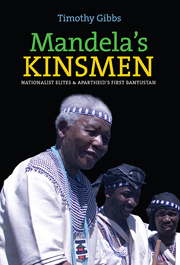Book contents
- Frontmatter
- Contents
- List of Maps and Figures
- Acknowledgements
- List of Abbreviations
- Introduction: Mandela' Kinsmen
- 1 Education, Monarchy & Nationalism
- 2 The First Bantustan, 1954–1963
- 3 The Second Peasants' Revolt, Mpondoland 1960–1980
- 4 The Old Mission Schools, 1963–1980
- 5 The Comrade-King, Bantustan Politics 1964–1980
- 6 Chris Hani's Guerrillas, 1974–1987
- 7 The Apartheid Endgame, 1987–1996
- 8 The New South Africa & Transkei's Collapse, 1990 onwards
- Conclusion: African Nationalism & its Fragments
- Bibliography
- Index
3 - The Second Peasants' Revolt, Mpondoland 1960–1980
Published online by Cambridge University Press: 05 April 2014
- Frontmatter
- Contents
- List of Maps and Figures
- Acknowledgements
- List of Abbreviations
- Introduction: Mandela' Kinsmen
- 1 Education, Monarchy & Nationalism
- 2 The First Bantustan, 1954–1963
- 3 The Second Peasants' Revolt, Mpondoland 1960–1980
- 4 The Old Mission Schools, 1963–1980
- 5 The Comrade-King, Bantustan Politics 1964–1980
- 6 Chris Hani's Guerrillas, 1974–1987
- 7 The Apartheid Endgame, 1987–1996
- 8 The New South Africa & Transkei's Collapse, 1990 onwards
- Conclusion: African Nationalism & its Fragments
- Bibliography
- Index
Summary
Govan Mbeki's book
In 1962 Govan Mbeki languished in detention, his role as the mastermind of the sabotage campaign in the Eastern Cape having been exposed by the failure of a bomb explosion in the Engcobo district of Transkei. Whilst in solitary confinement, Govan Mbeki illicitly resumed work on what was to become his most famous book, The Peasants' Revolt. The book was published in Britain, thanks to the editing efforts of Ruth First, who meshed the prison manuscript, which had been written on toilet paper, together with earlier drafts.
The Peasants' Revolt was a celebration of the rural revolt of the Eastern Mpondoland districts of Transkei a few years earlier in 1960. Thus far, our narrative has largely concerned the large kingdom of Thembuland, whose districts run from the central town of Umtata into the mountains that mark the north-western boundaries of the Transkei territories. Eastern Mpondoland (not to be confused Western Mpondoland – a more junior branch of the same royal stem) was the other major paramountcy in the Transkei territories. The Great Place of the Eastern Mpondo king was found at Quakeni in the southeastern corner of the Transkei region, between the Indian Ocean and the border of KwaZulu Natal, which is a sub-tropical area of deep valleys and forests. The purpose of Mbeki's book was to remind his fellow leaders in the ANC (many of whom had spent their energies in the 1940s and 1950s organising township protests) of the significance of the revolt in Eastern Mpondoland. It was the largest of a series of rural protests that came in the wake of the expansion of the apartheid state across the Native Reserves in the middle years of the 20th century.
- Type
- Chapter
- Information
- Mandela's KinsmenNationalist Elites and Apartheid's First Bantustan, pp. 48 - 69Publisher: Boydell & BrewerPrint publication year: 2014



